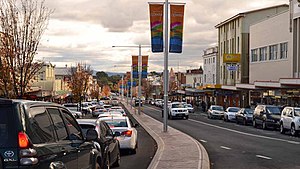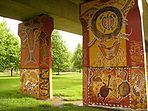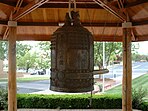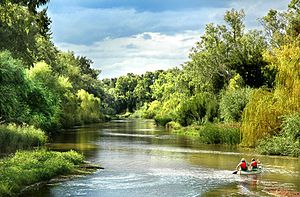Cucumgilliga, New South Wales
|
Cowra New South Wales |
|||||||||
|---|---|---|---|---|---|---|---|---|---|
|
From top to bottom, left to right: Kendal Street divides the CBD, the Eastern entrance to the town, the Japanese War Cemetery, Crops of canola create 'fields of gold', decorated in Aboriginal art, the pylons of the Cowra Bridge, Australia's World Peace Bell and the Lachlan River which flows through the heart of the town
|
|||||||||
| Coordinates | 33°50′6″S 148°41′33″E / 33.83500°S 148.69250°ECoordinates: 33°50′6″S 148°41′33″E / 33.83500°S 148.69250°E | ||||||||
| Population | 10,063 (2016 census) | ||||||||
| Established | 1846 | ||||||||
| Gazetted | 1849 | ||||||||
| Postcode(s) | 2794 | ||||||||
| Elevation | 310 m (1,017 ft) | ||||||||
| Time zone | AEST (UTC+10) | ||||||||
| • Summer (DST) | AEDT (UTC+11) | ||||||||
| Location | |||||||||
| LGA(s) | Cowra Shire | ||||||||
| County | Forbes, Bathurst | ||||||||
| State electorate(s) | Cootamundra | ||||||||
| Federal Division(s) | Riverina | ||||||||
|
|||||||||
Cowra is a town in the Central West region of New South Wales, Australia. It is the largest population centre and the council seat for the Cowra Shire, with a population of 10,063.
Cowra is located approximately 310 m (1,017 ft) above sea level on the banks of the Lachlan River in the Lachlan Valley. By road it is approximately 310 km (193 mi) South-West of the state capital Sydney and 189 km (117 mi) North of the nation's capital Canberra. The town is situated at the intersection of three major state highways the Mid-Western Highway, Olympic Highway and the Lachlan Valley Way.
Cowra is included in the rainfall records and weather forecast region for the Central West Slopes and Plains division of the Bureau of Meteorology forecasts.
The Wiradjuri people (Wiradjuri northern dialect pronunciation [wiraːjd̪uːraj]) Wiradjuri southern dialect pronunciation [wiraːjɟuːraj]) are a group of indigenous Australian Aboriginal people that were united by a common language, strong ties of kinship and survived as skilled hunter–fisher–gatherers in family groups or clans scattered throughout central New South Wales.
The first European explorer to the area, George William Evans, entered the Lachlan Valley in 1815. He named the area the Oxley Plains after his superior the surveyor-general, John Oxley. In 1817 he deemed the area "unfit for settlement". A military depot was established not long after at Soldiers Flat near present-day Billimari. Arthur Ranken and James Sloan, from Bathurst, were amongst the first white settlers on the Lachlan. They moved to the area in 1831.
The township of "Coura Rocks" had its beginnings in 1844. Around 1847, the township site became known as Cowra, and in 1849, was proclaimed a village.
In the 1850s many gold prospectors passed through headed for gold fields at Lambing Flat (Young) and Grenfell. The first school was established in 1857. The first bridge over the Lachlan River was built in 1870. Gold was discovered at Mount McDonald in the 1880s. The rail head, from Sydney, reached Cowra in 1886. Local government was granted in 1888. The first telephone exchange was established in 1901. The town water supply was established in 1909, the gasworks in 1912 and town supplied electricity was introduced in 1924.
...
Wikipedia








